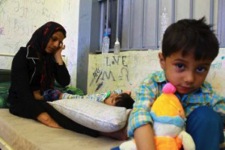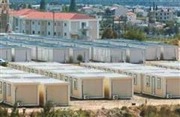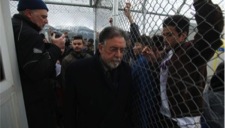This post is part of the joint blog series on ‘Gender and Migration’ co-hosted by Border Criminologies and COMPAS. Posts in this series will be published on both blogs every Friday until the end of June. You can follow Mary and Sharon on Twitter @MFBosworth and @ProfSPickering.
Greece is a buffering nation where irregular entry via the Greek-Turkish border circumvents all the ‘clean’ remote control border policies favoured by Western Europe, North America and Australia, and instead produces the contested conditions of irregularly crossing borders and the police work of countering and containing unwanted irregular mobility. Greece’s porous borders make policing of the external EU border particularly demanding and present an ever challenging task to border policing experts. In this post, drawing on extensive fieldwork conducted in 2010 including interviews with migrant women and border police officers in Greece, we want to touch on some interim lines of analysis about the different ways that crossing borders is gendered and racialised. The research took place in the Attica Aliens Police Directorate at Petrou Ralli Street, which holds both women and men, as well as children, where 30 semi-structured interviews were conducted with both staff and women migrants detained there.
 All of the women talked about their reasons for irregular entry into Europe in terms of gender violence or responsibilities: fleeing political violence which overlapped with threats or experiences of sexual violence in conflict or post conflict situations (and most women from Africa and Iraq talked about the deaths of male family members); or economic opportunities in relation to supporting family especially dependent children in the absence of male head of household. This latter category is in line with increasing research recognising women as the most reliable and desirable migrant labour provider between the developed and developing world. Women all stated that the decisions to undertake the illicit journey were their own―they all identified Europe as a destination themselves, and had made determinations themselves as needing to travel.
All of the women talked about their reasons for irregular entry into Europe in terms of gender violence or responsibilities: fleeing political violence which overlapped with threats or experiences of sexual violence in conflict or post conflict situations (and most women from Africa and Iraq talked about the deaths of male family members); or economic opportunities in relation to supporting family especially dependent children in the absence of male head of household. This latter category is in line with increasing research recognising women as the most reliable and desirable migrant labour provider between the developed and developing world. Women all stated that the decisions to undertake the illicit journey were their own―they all identified Europe as a destination themselves, and had made determinations themselves as needing to travel.
However, there’s a big gap between the ways women see themselves and how they are seen by others. Similar to other case studies, Greek border police referred to women in infantalising ways.
They get fooled. Before they arrive here they are told that they are going to work in houses and such and they end up on the street. They don’t know what they are doing and where they are going. Women don’t have an idea. (Vassilis, Chief of the detention department)
Women who irregularly cross borders were doubly stigmatised; first, for their contravention of gender-based expectations and second, for their breach of the border. If women’s choices are considered poorly calculated and in need of correction, the detainees themselves are often viewed by detention officers as morally and intellectually suspect. Two significant discourses emerged―that of women as cultural slaves, or of animals. Both evidence a heavy investment in what Sinha has called the cultural hook to produce and explain deviance.
They are not able to freely move around, they can’t talk to anyone, they just come to Greece and become slaves. So in a way in here they have a better life, because we feed them and provide them with accommodation. (Anastasia, detention officer)
Police repeatedly referred to migrant women as animals and used tropes of failed motherhood to assign an unnatural state from which their deviance was derived.
Iraqis have a certain mentality, that women have to be animals. I’m not saying this to offend them but this is their way of thinking because of their religion, their culture, as a country, as a people. Women have to animals, be uneducated, not knowing what’s going on around them, have babies all the time. (Xenia, detention officer)
The above pattern broadly confirms decades of feminist criminological research on women’s offending as being seen as ‘doubly bad’ especially for women of colour. Ironically, women’s efforts to meet changing gender expectations in their countries of origin of familial obligation, especially regarding financially providing for their families, doesn’t factor into such assessments. In short, there’s no attempt to recuperate narratives of good motherhood that drives some women to seek out financial security through insecure migration and illicit labour. Women’s own narratives of providing for children and aging parents are unable to disrupt scripts of failed gender at the border.
Traditional gendered ideologies became ensnared in the spaces created by the hyper-politics of border control. Gender roles operated as a drag on women’s international migration, even irregular migration. Gender works to delegitimise women as transnational migrants, especially in the face of increasing border control. The sorting of desirable from undesirable migrants at the border is heavily invested in ‘civilising’ tropes and gendered moralities. Border control has provided another, potent, opportunity to not only reject, but to demean and diminish racially othered women. The complexity of women’s survival, of their sexual decisions and their labour, fade in the spaces of border control. Yet there are few indications that women’s irregular border crossing will change as a result. For women, these spaces are not the focus of their survival. The border is not the main focus. Yet, officials keep their individual and collective racial and gendered stare fixed upon the woman and the border. This incongruence is surely unsustainable.
At the moment, we know very little about daily life in Greek detention centres other than what we can glean from reports by NGOs and policy documents. The information becomes even scanter when it comes to the experiences of women detainees, who have very rarely been studied in their own right as they represent only a small percentage of the total reported detained population in Greece.
There is little official clarity over how many women are detained in one of the many detention sites currently operating in Greece. According to the Director of the Aliens Division of the Ministry of Public Order, there are nine dedicated detention facilities, most former military sites, with a total capacity of around 5,000 men, women and children. Yet, in reality, resourceful Hellenic Police employ at least 18 more sites ranging from border guard posts to police stations throughout the Greek territory, rendering the number of detainees unknown. What is more, with the exception of those women who have lodged an asylum application (1,126 women for a six-month period in 2014) and those who have requested accommodation (686 women in 2014), other statistics given by the Hellenic Police don’t make reference to the gender of applicants. The official position of the state is that there are no official statistics breaking down by gender those aliens arrested either when entering irregularly or at a later stage.
Is this about to change? The Deputy Minister of Immigration, Tasia Christodoulopoulou, of the newly elected left-wing government, has stated that one of the first goals of the newly formed Ministry, along with closing down immigration detention centres, is to register the immigrant and refugee population currently on Greek territory. However, this was followed by dubious claims that there are no destitute refugees living on the streets, they just hang out in squares to enjoy the sun, hinting once again at the true meaning of Greek hospitality, only this time it’s not Xenios Zeus, who welcomes irregular migrants but hospitable Helios (God of the Sun in Greek mythology).
Greece, like many member states of the EU, has for many years been aggressively enlarging its detention capacity as a key means of managing its border and its internal population of foreign nationals. The newly elected government has recently announced radical immigration reforms. ‘Detention centres―we're finished with them,’ Deputy Interior Minister Yannis Panousis, who’s in charge of public order and civil protection, told reporters on a visit to Amygdaleza detention centre, following the suicide of a Pakistani detainee and consequent uprising of detainees. Statements like this signal a 180-degree turn from the focus on detention and border patrols, which has dominated the country's migration policy for more than a decade.
However, it remains unclear how immigration authorities will deal with those released or if the conditions will change for those still detained in many of the country’s detention centres. Given that the numbers of new arrivals in 2015 are only expected to increase, it remains to be seen whether the ambitious reforms will become part of Greece’s immigration policy. In order for its immigration agenda to succeed, Syriza, the lead party in the government coalition, will need to not only win support from its skeptical coalition partner, but also to gain the cooperation of Greece’s security and border authorities, who for far too long have seen migration as a burden and especially, women migrants as slaves and less than human.
For more on this study, see our forthcoming chapter in Immigration Detention, Risk and Human Rights (Springer), edited by Maria Joao Guia, Robert Koulish, and Valsamis Mitislegas.
Author affiliations: Mary Bosworth (Centre for Criminology, University of Oxford), Sharon Pickering (School of Political & Social Inquiry, Monash University), and Andriani Fili (Centre for Criminology, University of Oxford)


